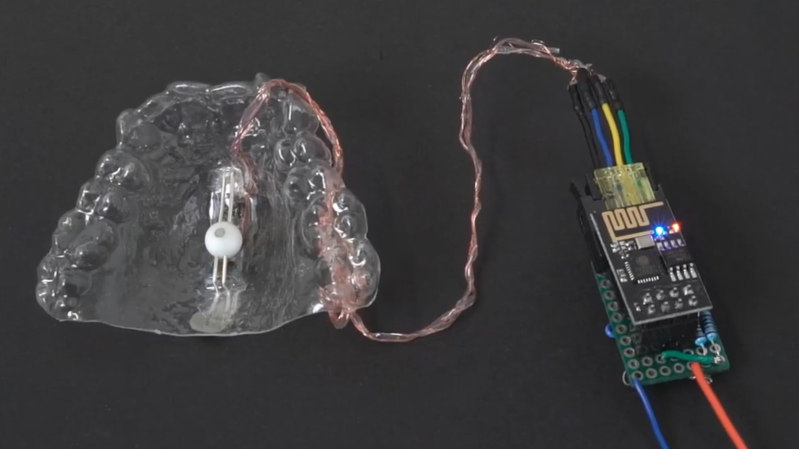For interfacing with machines, most of us use our hands and fingers. When you don’t have use of your hands (permanently or temporarily), there are limited alternatives. [Dorothee Clasen] has added one more option, [In]Brace, which is basically a small slide switch that you can operate with your tongue.
[In]Brace consists of a custom moulded retainer for the roof of your mouth, on which is a small ball with an embedded magnet, that slides long wire tracks. Above the track is a set of three magnetic sensors, that can detect the position of the ball. On the prototype, a wire from the three sensors run out of the corner of the users mouth, to a wireless microcontroller (Which looks to us like a ESP8266) hooked behind the user’s ear. In a final product, it would obviously be preferable if everything were sealed in the retainer. We think there is even more potential if one of the many 3-axis hall effect sensors are used, with a small joystick of rolling ball. The device could be used by disabled persons, for physical therapy, or just for cases where a person’s hands are otherwise occupied. [Dorothy] created a simple demonstration, where she plays Pong, or Tong in this case, using only the [In]Brace. Hygiene and making sure that it doesn’t somehow become a choke hazard will be very important if this ever became a product, but we think there is some potential.
[Kristina Panos] did a very interesting deep dive into the tongue as an HMI device a while ago, so this isn’t a new idea, but the actual implementations differ quite a lot. Apparently it’s also possible to use your ear muscles as an interface!
Thanks for the tip [Itay]!
















interesting and bwesome ..
At first I thought this was going to be tongue in cheek.
Sorry; couldn’t help myself.
I wonder if tounge movements can be sensed electrically with EMG pads around your face, to avoid the annoyance of having something in your mouth?
yes. There’s a project that determines silent speech through EEG sensors on the jaw.
That sucks-
>I wonder if tounge movements can be sensed electrically with EMG pads around your face, to avoid the annoyance of having something in your mouth?
Neck, not face.
Put your hand where your neck meets your jaw and move your tongue around.
the magnetometers in todays telephonic devices are so sensitive, the only thing that needs to be in your mouth is the magnet. Looking at the X,Y,Z data, you can easily determine the orientation of a NdFeB magnet from a significant distance. I want to (but will likely just think about it like i have occasionally for the past decade) develop an app that allows one to use a magnet as a non-contact, batteryless H.I.D. that would have certain advantages over the conventional digitizer, such as working with wet fingers, working from 6 feet away, and just working at all, in the event of a well placed screen fracture. Multiple magnets, packed in something like dice or retro mouse balls, could be ‘keyed’ by polarity/orientation to help the device identify individual H.I.D’s. using your phone could even be as simple as tilting a ring on your finger like a ‘TrackPoint’ joystick and tapping it to click.
Tongue gestures?
Don’t really see the benefit to already commercial aviable products like https://tks-technology.dk/de/products/ disabled people can already get
One has still to put a magnetic “piercing” in the mouth – which can be swallowed or will not stick to the tongue.
EMG (look at google scholar for tanja Schultz and EMG) or inEar is in my opinion the way to go. Even with the inEar devices one can detect tongue movement and gestures.
Ben of applied science made a similar device way back in 2013 https://m.youtube.com/watch?v=HyaiszgzIzo